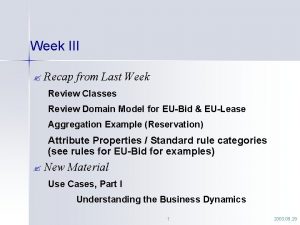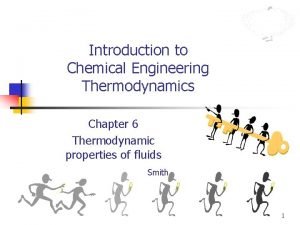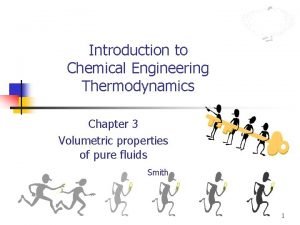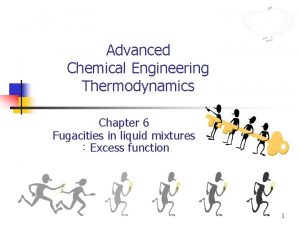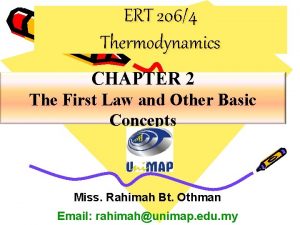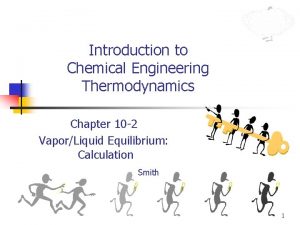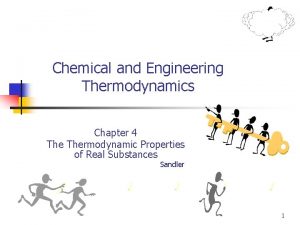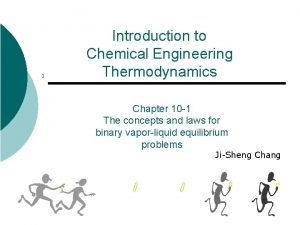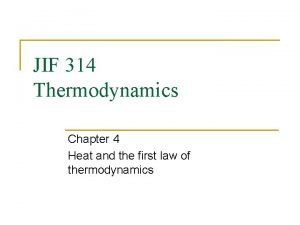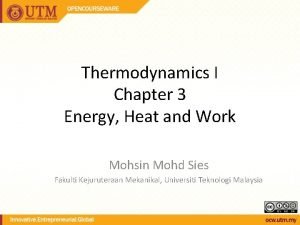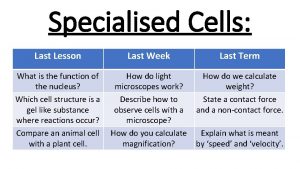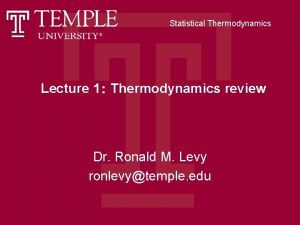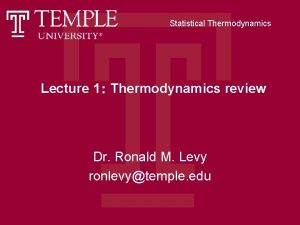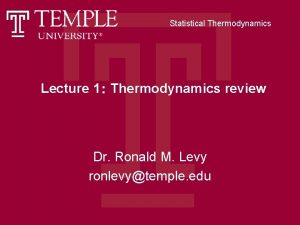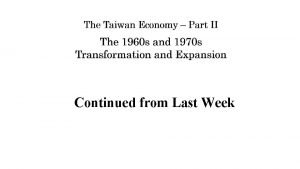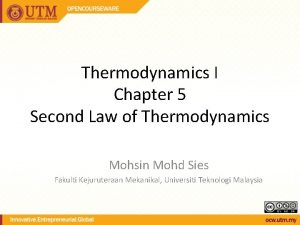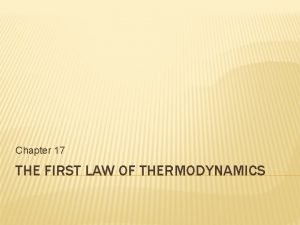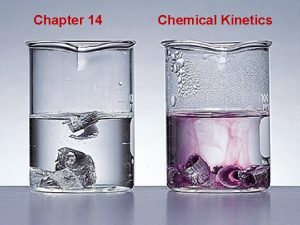Chapter 3 Thermodynamics Review from last week 2












































- Slides: 44

Chapter 3 Thermodynamics

Review from last week 2

3

The First Law of Thermodynamics • 4

Lagrangian VS Eulerian Frameworks Eulerian = a framework that is fixed in space • What is observed by a weather station at a fixed location. • Atmospheric properties will change as wind blows air with different properties past the fixed location. Lagrangian = a framework that follows air as it moves through the atmosphere • Can think of it as a small dust particle moving exactly with the wind and observing how the atmosphere changes. 5

Heat Budget of an Unsaturated Air Parcel • Lagrangian form of the First Law of Thermodynamics Temperature change of the parcel Changes due to vertical movement 6 Energy added to the parcel

• Poisson’s Equation Always use SI units!! (temperature in K and pressure in Pa) 7

Thermodynamic Diagram isotherms = lines of constant temperature Pressure isobars = lines of constant pressure dry adiabats = lines of constant potential temperature Temperature 8

Today: Heat Budget at a Fixed Location 9

Heat Budget at a Fixed Location Lagrangian form of the First Law of Thermo • 10

Heat Budget at a Fixed Location • Change in temperature at a fixed location over time Addition or removal of energy (heat) from the air at a fixed location But what processes can add or remove heat from an air parcel? 11

Heat Budget at a Fixed Location Processes that can add or remove heat from an air parcel: • Heat can be transported into or out of the air parcel • Heat can be released or consumed within the air parcel 12

Heat Budget at a Fixed Location • Heat transport into/out of the air parcel 13 Heat released or consumed within the air parcel

Heat Budget at a Fixed Location • 14

Heat Flux Divergence • How do you determine the sign of the heat flux divergence? 15

Heat Flux Divergence To determine the sign of the heat flux divergence, you need to see if more heat is entering or exiting the box. Same principle can be applied to the 2 other directions! 16

Heat Flux Divergence Under what condition will the heat flux divergence term cause the temperature of the box to increase (decrease)? • If the heat flux divergence is positive, more heat enters than leaves the box, which causes warming. • If the heat flux divergence is negative, more heat leaves than enters the box, which causes cooling. 17

Heat Flux Divergence • Advection = movement by mean wind Conduction = through contact with adjacent air Turbulence = transport by turbulent flow 18 Radiation Same principle applies for the 2 other directions!

Internal Sources of Heat • → The main internal source or sink is latent heat associated with water phase changes. 19

Advection of Heat Advection = the transport of an atmospheric property by the movement of air (wind). Temperature advection = the transport of heat with the wind. How will the temperature at a fixed weather station change if a south wind is blowing and it is warmer to the south than to the north? → This will cause the temperature at the fixed weather station to increase over time. 20

Advection of Heat The advective heat flux divergence terms in the first term on the right hand side of the First Law of Thermodynamics can be calculated as: 21

Advection of Heat • 22

Conduction of Heat All energy transfer between the surface and the atmosphere occurs by conduction. Once energy is deposited into the atmosphere, atmospheric motions (wind and turbulence) can transport it. Molecular heat conduction occurs as molecules with different temperatures (molecular kinetic energy) transfer their energy to adjacent molecules. 23

Conduction of Heat Is the conductive heat flux important in the atmosphere? → It is only important at the surface. It is unimportant elsewhere because air is a poor heat conductor and temperature gradients (which drive conduction) are small away from the surface. 24

Atmospheric Boundary Layer (ABL) ABL = The lower portion of the atmosphere that feels the influence of the underlying surface. The effects of the Earth’s surface on the ABL include: • diurnal heating and cooling • slowing of the wind due to surface drag Normally, the ABL is 1 -2 km deep but can be as shallow as a few meters to hundreds of meters at night and be 5 km deep or more during daytime in a desert/semi-arid environment. 25

Atmospheric Boundary Layer (ABL) A defining characteristic of the boundary layer is that it is turbulent. We can recognize a turbulent portion of the atmosphere by the gustiness of the wind. Reminder → Conduction is the primary way heat is transferred from the ground to the adjacent air. 26

Atmospheric Boundary Layer (ABL) • 27

Atmospheric Boundary Layer (ABL) • 28

Solar and Infrared Radiation The radiative heat flux divergence must be estimated when using the First Law of Thermodynamics to calculate the rate of change of temperature in the atmosphere. How will the amount of solar and infrared radiation absorbed and emitted by the atmosphere vary spatially? 29

Solar and Infrared Radiation • 30

Internal Sources of Heat • 31

Internal Sources of Heat • 32

Simplified Eulerian Heat Budget • 33

Simplified Eulerian Heat Budget • Change of temperature with time at a fixed location Advection of heat by the horizontal wind Turbulent transport of heat in the vertical Latent heat due to water phase change We can use this equation to predict how temperature will change if we know all of the terms on the RHS! 34

Heat Budget at the Earth’s Surface We consider that the surface of the Earth has no mass (it is an infinitesimally thin interface) so it cannot store heat. As a result, the incoming and outgoing fluxes at the surface must exactly balance to conserve energy. 35

Heat Budget at the Earth’s Surface • Negative because this flux is from below the surface 36

Heat Budget at the Earth’s Surface • 37

Heat Budget at the Earth’s Surface • 38

Heat Budget at the Earth’s Surface During the day → Ground is warmed by radiative flux and air is warmed by turbulent fluxes. During the night → Ground cools by the radiative flux and air cools by turbulent fluxes. Radiative cooling = a process in which the ground and the air lose energy by radiating infrared energy. 39

Heat Budget at the Earth’s Surface How do the surface energy budget terms vary if the surface is dry or moist? • Dry: increase in turbulent heat flux & decrease in latent heat flux. • Moist in dry environment: large latent heat flux & downward turbulent heat flux as warm, dry air blows over the cool, moist oasis. 40

Heat Budget at the Earth’s Surface How is the atmosphere heated on a clear, sunny day? • Solar radiation passes through the atmosphere and is absorbed by the ground, which warms the ground. • The warmed ground transfers energy to the air by conduction and turbulence (both sensible and latent heat). • The ground also emits LW radiation, which is absorbed by the atmosphere. 41

Heat Budget at the Earth’s Surface Radiation (or nocturnal) inversion = An increase in temperature away from the surface due to radiative cooling of the ground. How? • The ground is cooled strongly by longwave radiation at night. • The atmosphere transfers energy by turbulent fluxes to the cooled ground and thus is cooled. • This is effective only in a shallow layer so only the lowest part of the atmosphere is cooled. 42

43

Heat Budget at the Earth’s Surface Why is the coldest air at night often found in valley bottoms? • The ground on all sides of the valley is cooled at night by longwave radiation. • Cold air is more dense than warm air and flows downhill under the influence of gravity. • This causes cold air to pool in valley bottoms. 44
 Week by week plans for documenting children's development
Week by week plans for documenting children's development Lesson 10: thermodynamics unit review
Lesson 10: thermodynamics unit review What you last weekend?
What you last weekend? What did you do last saturday
What did you do last saturday Window was broken
Window was broken We played football
We played football Last weekend i went to my friend's birthday party
Last weekend i went to my friend's birthday party What was the weather like yesterday?
What was the weather like yesterday? Did you finish your assignment
Did you finish your assignment Where did you last weekend
Where did you last weekend Recap from last week
Recap from last week Last week we installed a kitty door
Last week we installed a kitty door Last week summary
Last week summary If the books have been cataloged last week
If the books have been cataloged last week Last week of lent
Last week of lent Last week's homework
Last week's homework Last week in japanese
Last week in japanese Past simple watch tv
Past simple watch tv Last summer holiday
Last summer holiday The last week of jesus life
The last week of jesus life The doctor gave me a for some medicine last week
The doctor gave me a for some medicine last week He she was were
He she was were Last week
Last week Last week's lesson
Last week's lesson Last week's homework
Last week's homework Chapter review motion part a vocabulary review answer key
Chapter review motion part a vocabulary review answer key 5 a day language review week 7
5 a day language review week 7 Daily language review week 18 answers
Daily language review week 18 answers Daily language review week 16 answer key
Daily language review week 16 answer key Paranoia in a sentence
Paranoia in a sentence Daily language practice
Daily language practice Dgp week 10 answers
Dgp week 10 answers Chemical engineering thermodynamics 8th solution chapter 6
Chemical engineering thermodynamics 8th solution chapter 6 Chemical engineering thermodynamics 8th solution chapter 3
Chemical engineering thermodynamics 8th solution chapter 3 Thermodynamics for chemical engineering
Thermodynamics for chemical engineering Chemical engineering thermodynamics 8th solution chapter 6
Chemical engineering thermodynamics 8th solution chapter 6 Control mass
Control mass Chemical engineering thermodynamics 8th solution chapter 10
Chemical engineering thermodynamics 8th solution chapter 10 Thermodynamics chapter 4
Thermodynamics chapter 4 熱力
熱力 Thermodynamics chapter 4
Thermodynamics chapter 4 Q=w/j
Q=w/j Chemical engineering thermodynamics 8th solution chapter 2
Chemical engineering thermodynamics 8th solution chapter 2 Chapter 6 career readiness chapter review answers
Chapter 6 career readiness chapter review answers Uncontrollable spending ap gov
Uncontrollable spending ap gov










